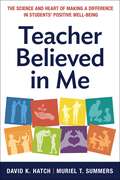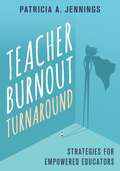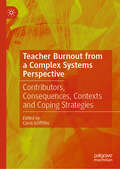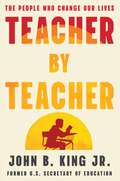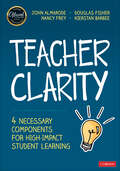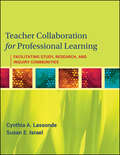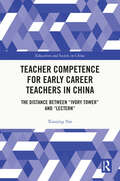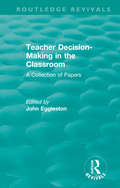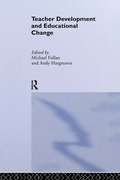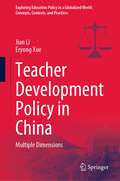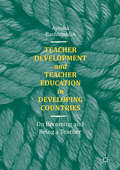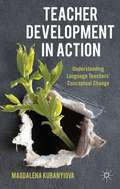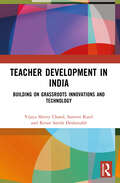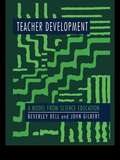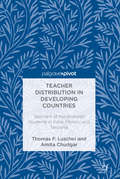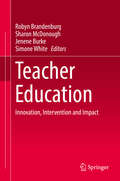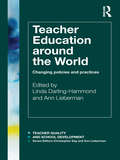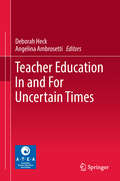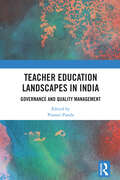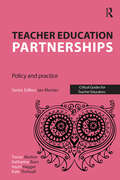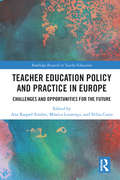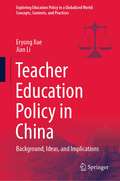- Table View
- List View
Teacher Believed in Me: The Science and Heart of Making a Difference in Students' Positive Well-Being
by David K. Hatch Muriel T SummersFrom the bestselling team behind classics like The Leader in Me comes a supremely practical and inspiring guide to making a profound difference in students&’ positive well-being and reigniting teachers&’ passions for teaching.In this inspirational guide, FranklinCovey Education&’s global thought leaders Dr. David K. Hatch and Muriel Summers reveal seven leadership skill sets that enable teachers to profoundly impact students&’ positive well-being and academic success. Drawing upon extensive research and their decades of experience in helping to transform more than 8,000 schools across the globe, the authors provide practical best practices for connecting with students and empowering them to achieve their full potential. Teacher Believed in Me equips teachers with tools to: -Accept students as they are, building a foundation of belonging -Teach meaningful life lessons that resonate beyond the classroom -Inspire students to discover and develop their unique strengths -Entrust students with responsibilities that build self-worth -Support students with empathy and optimism when they face challenges -Empower students to take ownership of their learning and growth -Provide correction and feedback in positive, constructive ways Packed with simple, actionable, evidence-based practices, Teacher Believed in Me demonstrates how forging authentic connections, nurturing wellness, and meeting core psychological needs can reignite students&’ engagement and unlock their innate greatness. Whether teachers and administrators are looking for a fresh perspective or simply seeking renewed motivation for working with students, this book is grounded in the current, everyday realities of teaching.
Teacher Burnout Turnaround: Strategies For Empowered Educators
by Patricia A. JenningsHope for overcoming teacher burnout, from a mindfulness expert. Stress and burnout are eroding teachers’ motivation, performance, quality of classroom interactions, and relationships with students, as well as their commitment to the profession. Principals are leaving in droves, and teacher shortages are becoming the new normal. Our teachers are underappreciated and our schools underresourced. But, as the author of Mindfulness for Teachers and The Trauma-Sensitive Classroom points out, educators themselves have the power to alter this downward spiral. Educational psychologist Tish Jennings presents a matrix of stress-causing factors that lead to burnout, and shows how teachers can tackle the sources of stress at each pressure point. From the development of social and emotional competencies—so important to teachers and students alike—to the achievement of systemic change through collective efficacy, she offers hope and practical remedies for overcoming a toxic trend in education.
Teacher Burnout from a Complex Systems Perspective: Contributors, Consequences, Contexts and Coping Strategies
by Carol GriffithsThis edited book investigates the factors contributing to teacher burnout and its potential consequences. Topics include the relationship of burnout to cultural identity, modality and job satisfaction, and chapters discuss various settings such as the English as a Medium of Instruction (EMI) classroom, secondary and primary schools. The book aims to provide possible solutions and ways forward for tackling the issue of burnout, both at a personal and systemic level. It will be of interest to students and scholars in the fields of teacher education, wellbeing, school and schooling, as well as practising teachers and school leadership.
Teacher By Teacher: The People Who Change Our Lives
by John B. King Jr.Teacher By Teacher traces the remarkable journey of the 10th U.S. Secretary of Education and is a deeply personal love letter to all the teachers in our lives. The story of John B. King Jr.&’s inspiring path to President Obama&’s Cabinet begins the day that his mother died. He insisted on going to school that day, knowing he would find comfort in his classroom. As he navigated living alone with a father dying from undiagnosed Alzheimer&’s, it was public school teachers who saved his life. King&’s teachers believed in him and saw his potential. They made school a safe, supportive, and engaging place where King could be a kid despite the challenges at home. While some might have dismissed a rebellious young Black and Puerto Rican teen whose life was in crisis, King&’s teachers and counselors gave him a second chance. King went on to earn degrees from Harvard, Columbia, and Yale and committed his career to trying to do for other young people what educators did for him. Teacher By Teacher is an inspiring account of how dedicated educators—both King&’s own teachers and the phenomenal teachers who he has encountered throughout his career as a teacher, principal, and education policymaker—can profoundly shape the lives of their students. King&’s experiences constantly reinforce the role of schools as places of survival, healing, and hope. This book is about overcoming challenges and the mentors who help us make it through them. Teacher By Teacher should inspire students, parents, teachers, and everyone who believes in the transformative power of education. But more than that, this book examines the life-changing impact of mentorship, especially for those who are underserved by public institutions and social systems in America.
Teacher Clarity: Four Necessary Components for High-Impact Student Learning
by Douglas Fisher Nancy Frey Kierstan Barbee John T. AlmarodeHow to Activate and Accelerate Student Learning Have you ever given instructions to your students, only to receive blank stares or confusion? Clarity is an essential part of teaching and learning, and every interaction we have with students is the foundation for moving learning forward—we must make every interaction count. Backed by the latest education research on what really works, Teacher Clarity spotlights the newest and best teaching strategies and explains the importance of clear learning intentions, success criteria, lesson design, progress monitoring, and more. Inside, you’ll discover how teacher clarity Helps educators make informed decisions around teaching and learning Demands that educators keep the "big picture" in mind Allows educators to integrate optimal teaching and learning experiences at the right time Tells us what evidence we must generate around teaching and learning and what steps to take next Organized around the four critical components of teacher clarity—organization, explanations, examples, and assessments—and filled with samples for all content and grade levels, Teacher Clarity is your essential guidebook for unlocking your learners’ potential.
Teacher Clarity: Four Necessary Components for High-Impact Student Learning
by Douglas Fisher Nancy Frey Kierstan Barbee John T. AlmarodeHow to Activate and Accelerate Student Learning Have you ever given instructions to your students, only to receive blank stares or confusion? Clarity is an essential part of teaching and learning, and every interaction we have with students is the foundation for moving learning forward—we must make every interaction count. Backed by the latest education research on what really works, Teacher Clarity spotlights the newest and best teaching strategies and explains the importance of clear learning intentions, success criteria, lesson design, progress monitoring, and more. Inside, you’ll discover how teacher clarity Helps educators make informed decisions around teaching and learning Demands that educators keep the "big picture" in mind Allows educators to integrate optimal teaching and learning experiences at the right time Tells us what evidence we must generate around teaching and learning and what steps to take next Organized around the four critical components of teacher clarity—organization, explanations, examples, and assessments—and filled with samples for all content and grade levels, Teacher Clarity is your essential guidebook for unlocking your learners’ potential.
Teacher Collaboration for Professional Learning
by Cynthia A. Lassonde Janice F. Almasi Susan E. IsraelTeacher Collaboration for Professional Learning contains the essential information, tools, and examples teachers and school leaders need to create, manage, and sustain successful collaborative groups. Designed to be a hands-on resource, this practical guide shows you how to: Advocate for collaborative teacher learning Develop and sustain collaborative research groups Organize and conduct productive research projects Address issues of ethics, leadership, and group dynamics Evaluate and sustain collaborative learning activities Based on data from a major survey, Teacher Collaboration for Professional Learning features extensive case examples from model research communities collaborating within schools, across districts, in partnership with universities, and as online networks. The book also offers a wealth of reproducible templates as well as reflection questions and exercises?invaluable tools for organizing study groups.
Teacher Competence for Early Career Teachers in China: The Distance between “Ivory Tower” and “Lectern” (ISSN)
by Xiaojing YanExamining the teacher education landscape in China, Xiaojing Yan focuses on how early career teachers (ECTs) build their competence during the initial years of teaching, challenges that come with teacher training and pathways to improve teacher competence.Although there is a growing trend in China to focus on teacher quality and professional development, teacher competence varies across teacher groups: ECTs, in particular, face a variety of challenges in the initial period. Using a qualitative-based approach, Yan examines 55 teacher education policies and 3 education laws between 1949 and 2019 in China. The chapters offer valuable insights into teacher education policy and practice, as well as teachers' professional development strategies and competence growth at the secondary level. With teacher’s needs in mind, this book provides a framework for policy development and teaching implementation, as well as for teachers' practices and effective professional learning.Discussing critical issues and opportunities in the development of ECTs competence, this book will appeal to researchers, students and practitioners across the fields of teacher education and professional learning development. It will also be relevant and accessible to policymakers involved in education and teacher training.
Teacher Decision-Making in the Classroom: A Collection of Papers (Routledge Revivals)
by John EgglestonMaking decisions is one of the main activities of the teacher’s work. Considered or apparently unconsidered, these decisions significantly affect the lives of all who work in classrooms, both children and the teachers themselves. Originally published in 1979, the aim of this collection of papers was to achieve greater understanding of classroom decision-making and its consequences, to identify and map existing knowledge, and to indicate where it might be augmented. The contributors were researchers and teachers from schools, universities and colleges at the time, and they examine the process of teacher decision-making from sociological, psychological, economic and other perspectives. The book includes a detailed analysis of life in the classroom from a phenomenological perspective, explorations based on micro-economic techniques, and structural perspectives on the role of the teacher in the school. The concluding papers examine the possibilities for social change, given the constraints on the work of the teacher.
Teacher Development And Educational Change
by Andy Hargreaves Michael FullanFirst published in 1992. Routledge is an imprint of Taylor & Francis, an informa company.
Teacher Development Policy in China: Multiple Dimensions (Exploring Education Policy in a Globalized World: Concepts, Contexts, and Practices)
by Jian Li Eryong XueThis book comprehensively explores the teacher development policy in China from multiple dimensions. It examines the leading value of 'Four Good Teachers', teacher salary management policy, teacher evaluation policy, teachers’ professional title appointment policy, teachers’ ethic policy in China’s education system, 'County management and school recruitment' policy in teacher management, teachers’ honor recognition policy, and teachers’ qualification management and policy in China. This book not only shares in-depth understanding to epitomize teacher development policies in China contextually, but also provides specific suggestions to address various challenges of teacher development policies both nationally and locally.
Teacher Development and Teacher Education in Developing Countries: On Becoming and Being a Teacher
by Ayesha BashiruddinThis book contributes to understanding of how individual teachers in developing countries grow and evolve throughout their careers. Based on the analysis of 150 autobiographies of teachers from a range of regions in the developing world including Central Asia, South Asia, East Africa and the Middle East, the author celebrates individual teachers’ voices and explores their narratives. What can these narratives tell us about ‘becoming’ and 'being’ a teacher, and the process of teacher development? What is different about ‘becoming’ and ‘being’ a teacher in the developing world? By analysing the distinct narratives, the author explores these central questions and discusses the implications for further teacher development and education in these regions. In doing so, she transforms teachers’ embodied knowledge into public knowledge, shining a light onto the challenges they face in the Global South and exploring how research can be advanced in the future. This uniquely researched book will be of interest and value to students and scholars of education in the developing world.
Teacher Development in Action
by Magdalena KubanyiovaTeacher Development in Action offers a rich account of language teachers' engagement with the latest research in second language motivation on a year-long teacher development project. It offers an in-depth analysis of how language teachers mobilize (or not) their vast inner resources when they make sense of new material, and sheds light on why language classrooms do not always become acquisition-rich and motivating environments, even when teachers show great interest in new ideas and find them highly relevant to their practice. Drawing on a grounded theory ethnographic study of EFL teachers in Slovakia, this book breaks new theoretical ground in the language teacher cognition domain and weaves together findings from field notes, classroom observations and interviews into an integrated model of Language Teacher Conceptual Change (LTCC). The new insights into the complex and dynamic nature of teacher development constitute an original contribution to the field of applied linguistics and have significant implications for second language teacher education and development.
Teacher Development in Higher Education: Existing Programs, Program Impact, and Future Trends (Routledge Research in Education #83)
by Eszter Simon Gabriela PleschováConcerns about the quality of teaching and learning in higher education have given rise to teacher development programs and centers around the world. This book investigates the challenges and complexities of creating instructional development programs for present and future academics. Using case studies from a variety of countries including Estonia, Singapore, the United States and the United Kingdom, it examines issues that are important for higher education researchers as well as higher education managers. The book includes international responses to the need to improve teaching in higher education. It demonstrates many different ways success may be understood, and investigates what factors may influence the results of instructional development. Contributors use these factors to explain program success through theoretical frameworks. This book also provides input for higher-education managers by pointing out how the local context and both institutional and national policy-making may help or hinder the effective preparation of professors for their teaching responsibilities.
Teacher Development in India: Building on Grassroots Innovations and Technology
by Vijaya Sherry Chand Samvet Kuril Ketan Satish DeshmukhThis volume shows how grassroots educational innovations and technology can be brought together in a fresh approach to human resource development in public social services. Based on a three-decade-long engagement with innovation in public education, this book provides an illustration of how teacher-driven innovations can be transformed into learning objects for technology-based professional development. It describes how innovations can be identified, screened and validated, and disseminated through two mechanisms—a clearinghouse-based approach and grassroots innovation “fairs.” It then demonstrates how these innovations can form the backbone of a “third space,” problem-based-learning curriculum, which can be delivered through a technology platform for large-scale professional development. The book offers guidance on practical ways of doing this, and on evaluating the curriculum’s impact, with case studies of programmes that covered thousands of teachers. This book will be of interest to teachers, students and professionals in education, teacher education, digital education, information technology, communication and media studies. It will also be useful to educationists, policymakers, teacher educators, educational institutions, online education centres, and practitioners involved in professional development, education and training in developing countries.
Teacher Development: A Model From Science Education
by Beverley Bell John GilbertThis text proposes a model of teacher development as social, personal and professional development, and is based on the findings of a three year New Zealand research project. The project investigated the teacher development of some teachers of science working to: implement the findings of the previous "Learning in Science" projects; take into account students' thinking; and base their thinking on a constructivist view of learning. The factors that helped teacher development are discussed as is a view of learning to underpin teacher development. This book is intended to be of interest to teachers, teacher educators, teacher developers, school managers and policy makers working in all curriculum areas.
Teacher Distribution in Developing Countries
by Thomas F. Luschei Amita ChudgarThis book draws on case studies from India, Mexico, and Tanzania to examine the complex processes that lead to the educational marginalization of children through differential access to teacher quality. Growing evidence indicates that access to good teachers can boost the academic success of disadvantaged children and narrow achievement gaps between more and less privileged students. Yet in many countries, stronger teachers are concentrated in the classrooms of more advantaged children. Using a teacher labor markets framework, the authors explore the actions of those who employ teachers--the demand side--and teachers themselves--the supply side. Examining key junctures in the teacher career pipeline, from recruitment and training to retention and transfer, the authors find that the actions of the demand side often clash with teachers' preferences to live and work in satisfactory environments or to be close to home and family. Too often, the misalignment of the demand and supply sides places marginalized children at a profound educational disadvantage.
Teacher Education
by Robyn Brandenburg Sharon Mcdonough Jenene Burke Simone WhiteThis book, an inaugural publication from the Australian Teacher Education Association (ATEA), Teacher Education: Innovation, Intervention and Impact is both a product of, and seeks to contribute to, the changing global and political times in teacher education research. This book marks an historically significant shift in the collective work and outreach of the Australian Teacher Education Association (ATEA) as it endeavours to become an even more active contributor to a research-rich foundation for initial teacher education and to a research-informed teaching profession. The book showcases teacher education research and scholarship from a wide range of institutional collaborations across Australia. Studies highlight the multiple ways in which teacher education researchers are engaging with students, teachers, schools and communities to best prepare future teachers. It informs both teacher education policy and practice and is 'a must read' for those engaged in the education community. Above all it marks a shift for teacher educators to build a research rich teaching profession.
Teacher Education Around the World: Changing Policies and Practices (Teacher Quality and School Development)
by Linda Darling-Hammond Ann LiebermanTeachers are the most important single element of the education system but what does it take to create high quality teachers in today’s world? Around the world, countries are struggling to understand how to change their schools to meet global demands. International comparisons have shown that schools in Finland lead the league tables, but why is this, what new policies and practices in teacher education have they developed and how do they support the changes? A number of European and Asian countries also top the list when it comes to providing high quality teacher education, but there is little information about what and how they are doing the work and how they have made changes. The leading international contributors to this book describe the systemic policies and practices of teacher education in eight high-achieving countries and how they are dealing with teacher quality, equity, and the changing global society. Among the countries that are doing well – Finland, Singapore, the Netherlands, the UK, Hong Kong, Canada, Australia and the USA – there is an interesting diversity of policies and practices that support their changes in education, including: emphasis on the preparation, induction, support and assessment of new teachers focus on teacher retention, teachers’ professional knowledge and continuing professional development curriculum change and critical policies. In addition the chapters highlight the local cultural imperatives that influence and shape the preparation of quality teachers and make change both possible and problematic. Teacher Education Around the World examines what can be learned from the different countries, what policies and practices seem transferable; and which seem embedded in the particulars of the culture of the country. It describe themes that cut across all the countries, documenting not only what they are, but how the countries go about supporting and sustaining changes in teacher education. This book will prove itself an absolute essential for all those involved in teacher education, teaching and educational policy.
Teacher Education In and For Uncertain Times
by Angelina Ambrosetti Deborah HeckThis volume considers the role of initial and continuing teacher education in uncertain times. It highlights key principles and methods that preserve curiosity and optimism regarding the potential of teacher education, and regarding the manifold achievements of pre-service and in-service teachers. It explores how teacher education can produce teachers who are committed to counter-oppressive curricula and pedagogies, and reflects the critical role of teacher educators as public academics.
Teacher Education Landscapes in India: Governance and Quality Management
by Pranati PandaThis book examines the unexplored dimensions in the teacher education sector in India. It engages with critical concerns and attempts to provide a comprehensive and holistic perspective on how governance and quality management are conceptualised, debated, developed, and implemented in the teacher education sector in India. Drawing arguments from research and contributions of academicians, the book explores four central themes of teacher education, namely, governance and management in teacher education, management of pre-service teacher education, quality management in teacher education, and financing and political economy of teacher education. It focuses on the current operational model, situational efficiency, and provides a comprehensive analysis of the various reforms and initiatives taken at theoretical and practical levels for the transformation of teacher education.Presenting a focused overview of the critical dimensions of teacher education, and rich in empirical evidence, this book will be of interest to students, researchers, and teachers of education, sociology of education, urban education, politics of education, and educational studies. It will also be useful for teachers, teacher educators, academicians, scholars, and policymakers in the education sector.
Teacher Education Partnerships: Policy and Practice (Critical Guides for Teacher Educators)
by Katharine Burn Hazel Hagger Trevor Mutton Kate ThirlwallThis book supports all those involved in initial teacher education (ITE) and with an interest in partnership working. Such partnerships are at the heart of ITE practices, both in the UK and internationally, but more recently models of partnership have become ever more complex as a result of government reforms, the rapid diversification of routes into teaching and significant increase in the number of SCITTs. The nature of partnerships in ITE remains contested with partnership working often reduced to a series of prescriptions for effective practice, ignoring both its pedagogic potential and inherent tensions. This book surveys and critiques partnership developments in recent years and then analyses a single case study of a school that exemplifies the current complexity of ITE partnerships using both policy and practice perspectives. It concludes with a series of principles that might underpin effective partnership working.
Teacher Education Policy and Practice in Europe: Challenges and Opportunities for the Future (Routledge Research in Teacher Education)
by Ana Raquel Simões Mónica Lourenço Nilza CostaTeacher Education Policy and Practice in Europe provides a critical overview of the current challenges facing teacher education policy and practice in Europe. Drawing on a wide range of contributions, the book demonstrates that in order for teachers to reassume their role as agents of change, it is crucial to create a vision of a future European teacher and promote active engagement in preparing children to live and act in a multicultural and increasingly changing world. The book suggests ways in which teachers could be prepared to meet and overcome the struggles they will encounter in the classroom, including recommendations for teacher education, which open up new possibilities for policy, practice and research. Considering their own experiences as teachers, contributors also cover topics such as teacher education for the 21st century, the profile of the European teacher, citizenship and identity, social inclusion, linguistic and cultural diversity, and comparative education. Teacher Education Policy and Practice in Europe is essential reading for academics, researchers and postgraduate students engaged in the study of teacher education, educational policy and educational theory. It should also be of great interest to research-active teacher educators and practising teachers.
Teacher Education Policy and Research: Global Perspectives
by Diane MayerIn this book, leading teacher education researchers from Australia, Belgium, Canada, England, Finland, Hong Kong SAR, the Netherlands, New Zealand, North Ireland, Portugal, Scotland, the USA and Wales examine teacher education policy and research in each of their contexts.The book highlights the connections and disconnections between teacher education policy and research. It examines contemporary challenges and issues in teacher education including how high-quality teacher education is framed, how teaching quality is framed, and the role of teacher education research. It also considers future policy and research possibilities and opportunities for teacher education research, equity and preparing teachers for work within contexts of super-diversity, and early career teaching.
Teacher Education Policy in China: Background, Ideas, and Implications (Exploring Education Policy in a Globalized World: Concepts, Contexts, and Practices)
by Jian Li Eryong XueThis book explores the ideas and background of teacher education policy development in China and implications for the contemporary Chinese education system. In addition, it examines the key themes of teacher education policies since 1949, including investigating Teacher Exchange and Rotation Policy, Teacher Policy in the Perspective of China’s Alleviation of Education Poverty, Balanced Allocation Policy of Teachers in Chinese Urban and Rural areas, and the implementation effect evaluation of the free/public normal university student policy in China. All these policies contribute to explore the dramatic development of teacher education policy development in contemporary China.
